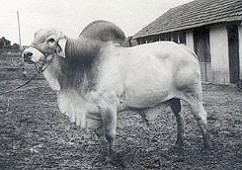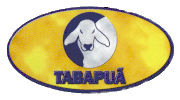Origins of the Tabapuan
The TABAPUAN has essentially tropical origins. In 1912, Antonio da Silva Neves wrote that „....hornless raffle were introduced by the colonists, generating a rustic homeless breed
which became very numerous. Thereafter it spread to the South-Araxa and Goiaz'
hornless cattle were at that time capable of reaching early maturity, they were vigorous,
they multiplied rapidly and were of superb breeding characteristics"
The Caracu and National Hornless breeds were already beeing bred by the Government of
the State of Sao Paulo as early as 1915, proving that the hornless has already been
adapted to tropic conditions for quite some considerable period.
The history of theTABAPUAN begins in the year l907 when José Gomes Louza from the
Leopoldo Bulhoes region in the state of Goiaz bought several Indian breeding bulls which
were imported to Brazil through the incentive of João Pinheiro. Three of those breeding bulls
wound-up in the hands of the brothers Salviano and Gabriel Guimarães, who were National
Hornless breeders in Planaltina, which is today part of the Federal Capital District. It was
in that region that the first hornless zebus arose. At that period in time, no one was
particularly interested in hornless cattle as beef stock, because big herds were not
appropriate for this type of cattle. The hornless breeds were prepared to be of dual
application and were not obliged to participate in long drives.
In the year 1912 various hornless examples of the Guimarães brothers efforts were shown
at the exposition in the city of Goiaz. These cattle already showed strong Zebu
characteristics. This is referred to in the magazine "informações goianas", printed
in that period.
Then, in 1930, Ravisio Lemos, through his importations, motivated Brazilian breeders to
return to the pure Indian races, a sentiment which continued up until the year 1945. During
the period there was little interest in hornless varieties because those which had true value
in the marketplace were all purebreeds.
Around about the year 1933, Lindolfo Louza, the son of José Gomes, purchased two bulls
and twenty-one hornless cows from the Guimarães brothers. At a later date, he transferred
these cattle to his son, Lourival Louza, who used them exclusively to cross with the Nellore
breed. These experiments, which took place on the Gameleira ranch, attracted some
attention in the region because they resulted in a hornless breed with Nellore characteristics,
better know as the "hornless white cattle".
In 1940, Francisco Inácio introduced Gir blood into this breed and it was already common
to encounter hornless animals in the herds that left Goiaz for S. Paulo. They were cattle of
a pale golden yellowish or reddish color.
One of these herds brought a good hornless cattle, with excellent beef characteristics to
Julio do Valle's ranch, the S.José dos Dourados. This fact is confirmed by Cardoso who
was, at that time, the foreman at the neighboring ranch of Francisco Inácio. These cattle
were maintained in addition to Julio's herd of half breed Nellore.
 Being aware of Dr. Alberto Ortenblad's interest in scientific research, Julio gave him, as a gift, the best young hornless bull from the recently arrived herd. This animal was called T-0.
Following that, Ortenblad was to separate 100 cows for the work which he began in 1943
applying rigorous techniques of animal husbandry. It was then that the true story of success
and continous study began. Brazil began to form a race...
Being aware of Dr. Alberto Ortenblad's interest in scientific research, Julio gave him, as a gift, the best young hornless bull from the recently arrived herd. This animal was called T-0.
Following that, Ortenblad was to separate 100 cows for the work which he began in 1943
applying rigorous techniques of animal husbandry. It was then that the true story of success
and continous study began. Brazil began to form a race...
The TABAPUAN, therefore, originates from the pale-golden National Hornless which, in turn, sistems from the crossbreeding of the National Hornless with cattle having Nellore
characteristics or with the Nellore itself. Afterwards, Guzerat blood was also perceived in
other herds.
With the evolution and success of the initial formation of that breed which was called
TABAPUAN (name of the district where the race began) achieved in thirty years of selection,
various other breeders with hornless herds, stemming from the National Hornless and the
Zebu, decided to adopt the pattern. Their animals, all of which began to adopt the
TABAPUAN denomination. This union gave origins to the Brazilian Association of Tabapuan
Breeders and, as a result, the rapid uniformization of emerging herd.
The TABAPUAN is the third of the "new zebu" races to have been created in the world. (The first and second beeing the, American Brahman and the Indubrasil). It is, however, the first
to have arisen out of a rigorous planning based on the precepts of animal husbandry. It is
a breed that was born to success...
Genetics - The economic results generated by a breed are directly linked to that breed's genetic superiority. In otherwords, they must, without fail, transmit their virtues.
Since the beginning, the TABAPUAN has maintained a high index of inbreeding, thereby
eliminating the defects and consolidating the virtues in various consecutive generations. It's
tough to do, but its worth it. Today the TABAPUAN is known for its notable morphological
and racial homogeinity. It is Brazil's major feat of animal husbandry over the period of the
last one hundred years. it has received merited acceptance and applause from the entire
world's scientific community.
Why the Tabapuan ?
Genetic Versatility - A good race is one which brings solutions to the most diverse situations by presenting different families or bloodlines which have been scientifically consolidated.
The TABAPUAN, having been developed to succeed in the different geoclimate conditions encountered in the tropics the best option. The TABAPUAN contains both the extremelly rustic blood of the cattle of the desert (Guzerat) as well as that of race stemming from the north of India (Nellore) which is famed for its early maturity and vitality.
A true champion of the scales - Brazil had already more than one hundred gain trials (in the city of Uberaba), held numerous contests for maximum weights and also tested more than three million animals in the program of Weight Development Control (CDP). In all of these testes the presence of the TABAPUAN is very marked, as we shall presently show. You can't argue with the scale.
A brazilian Brahman - The Americans created the Brahman race but, since the cattle are subject to the limitations of winter, the snows and stressful conditions of the Northern Hemisphere, they are currently introducing Brazilian blood from the NeLlore and the Guzerat to correct their herds. The Northern Hemisphere tends to form animals with a low index of hemoglobins and a high generation of organic heat while the tropical animals present high index of hemoglobins and a low generation of organic heat. No one can change nature in her widsom! The Americans are planning to get the point where the TABAPUAN has already been for quite some time. The TABAPUAN is the true "Tropical Brahman" or "NewZebu" scientifically strained to be a winner.
Scientific aspects - The TABAPUAN is excellently suited for beef, has notable maternal characteristics, is docile and productive. Scientifically, the process continues to create strains with low-levels of marbling and an elevated tenderness in the meat. The TABAPUAN is in the vanguard of the science of animal husbandry.
(From the booklet „Tabapuã, a Raça Brasileira", by the ABCT, 1993)


 Being aware of Dr. Alberto Ortenblad's interest in scientific research, Julio gave him, as a gift, the best young hornless bull from the recently arrived herd. This animal was called T-0.
Following that, Ortenblad was to separate 100 cows for the work which he began in 1943
applying rigorous techniques of animal husbandry. It was then that the true story of success
and continous study began. Brazil began to form a race...
Being aware of Dr. Alberto Ortenblad's interest in scientific research, Julio gave him, as a gift, the best young hornless bull from the recently arrived herd. This animal was called T-0.
Following that, Ortenblad was to separate 100 cows for the work which he began in 1943
applying rigorous techniques of animal husbandry. It was then that the true story of success
and continous study began. Brazil began to form a race...